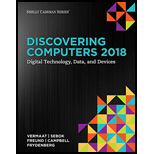
Discovering Computers ©2018: Digital Technology, Data, and Devices
1st Edition
ISBN: 9781337285100
Author: Misty E. Vermaat, Susan L. Sebok, Steven M. Freund, Jennifer T. Campbell, Mark Frydenberg
Publisher: Cengage Learning
expand_more
expand_more
format_list_bulleted
Question
Chapter 9, Problem 8PS
Program Plan Intro
- OS is the term that acts as an interface between the hardware and the user.
- It is the first
program loaded into the computer memory whenever the computer starts up. - It is responsible for the management and co-ordination of activities on a computer system.
- It is the most important program that runs on a computer is operating system.
- OS does basic operations such as getting input from the keyboard, displaying output in the monitor and monitoring the files.
- OS controls the peripheral devices like printers, hard drives and mouse.
- The responsibilities of OS are bound to get higher when it comes to security, because it provides the access rights for users.
Expert Solution & Answer
Want to see the full answer?
Check out a sample textbook solution
Students have asked these similar questions
4. |z + 5 - 5i| = 7
14.
dz,
C: |z❘
C: |z❘ = 0.6
ze² - 2iz
H
14.
dz,
C: |z❘
C: |z❘ = 0.6
ze² - 2iz
H
Chapter 9 Solutions
Discovering Computers ©2018: Digital Technology, Data, and Devices
Ch. 9 - Prob. 1SGCh. 9 - Prob. 2SGCh. 9 - Prob. 3SGCh. 9 - Prob. 4SGCh. 9 - Prob. 5SGCh. 9 - Prob. 6SGCh. 9 - Prob. 7SGCh. 9 - Prob. 8SGCh. 9 - Prob. 9SGCh. 9 - Prob. 10SG
Ch. 9 - Prob. 11SGCh. 9 - Prob. 12SGCh. 9 - Prob. 13SGCh. 9 - Prob. 14SGCh. 9 - Prob. 15SGCh. 9 - Prob. 16SGCh. 9 - Prob. 17SGCh. 9 - Prob. 18SGCh. 9 - Prob. 19SGCh. 9 - Prob. 20SGCh. 9 - Prob. 21SGCh. 9 - Prob. 22SGCh. 9 - Prob. 23SGCh. 9 - Prob. 24SGCh. 9 - Prob. 25SGCh. 9 - Prob. 26SGCh. 9 - Prob. 27SGCh. 9 - Prob. 28SGCh. 9 - Prob. 29SGCh. 9 - Prob. 30SGCh. 9 - Prob. 31SGCh. 9 - Prob. 32SGCh. 9 - Prob. 33SGCh. 9 - Prob. 34SGCh. 9 - Prob. 35SGCh. 9 - Prob. 36SGCh. 9 - Prob. 37SGCh. 9 - Prob. 38SGCh. 9 - Prob. 39SGCh. 9 - Prob. 40SGCh. 9 - Prob. 41SGCh. 9 - Prob. 42SGCh. 9 - Prob. 43SGCh. 9 - Prob. 44SGCh. 9 - Prob. 45SGCh. 9 - Prob. 46SGCh. 9 - Prob. 47SGCh. 9 - Prob. 48SGCh. 9 - Prob. 49SGCh. 9 - Prob. 1TFCh. 9 - Prob. 2TFCh. 9 - Prob. 3TFCh. 9 - Most users today work with a command-line...Ch. 9 - Prob. 5TFCh. 9 - Prob. 6TFCh. 9 - Prob. 7TFCh. 9 - Prob. 8TFCh. 9 - Many of the first operating systems were device...Ch. 9 - Prob. 10TFCh. 9 - Prob. 11TFCh. 9 - Prob. 12TFCh. 9 - Prob. 1MCCh. 9 - Prob. 2MCCh. 9 - Prob. 3MCCh. 9 - A _____operating system allows two or more...Ch. 9 - Prob. 5MCCh. 9 - Prob. 6MCCh. 9 - Prob. 7MCCh. 9 - Prob. 8MCCh. 9 - firmware a. operating system problem that occurs...Ch. 9 - Prob. 2MCh. 9 - thrashing a. operating system problem that occurs...Ch. 9 - Prob. 4MCh. 9 - drive a. operating system problem that occurs when...Ch. 9 - Prob. 6MCh. 9 - Prob. 7MCh. 9 - Prob. 8MCh. 9 - icons a. operating system problem that occurs when...Ch. 9 - Prob. 10MCh. 9 - Prob. 2CTCh. 9 - Prob. 3CTCh. 9 - Prob. 4CTCh. 9 - What is a cross-platform application?Ch. 9 - Prob. 6CTCh. 9 - Prob. 7CTCh. 9 - Prob. 8CTCh. 9 - Prob. 9CTCh. 9 - Prob. 10CTCh. 9 - Prob. 11CTCh. 9 - Prob. 12CTCh. 9 - Prob. 13CTCh. 9 - Prob. 14CTCh. 9 - Prob. 15CTCh. 9 - Prob. 16CTCh. 9 - Prob. 17CTCh. 9 - Prob. 18CTCh. 9 - Prob. 19CTCh. 9 - Prob. 20CTCh. 9 - Prob. 21CTCh. 9 - Prob. 22CTCh. 9 - Prob. 23CTCh. 9 - Prob. 24CTCh. 9 - Prob. 25CTCh. 9 - Prob. 26CTCh. 9 - Prob. 27CTCh. 9 - Prob. 28CTCh. 9 - Prob. 29CTCh. 9 - Prob. 1PSCh. 9 - Prob. 2PSCh. 9 - Prob. 3PSCh. 9 - Prob. 4PSCh. 9 - Prob. 5PSCh. 9 - Prob. 6PSCh. 9 - Prob. 7PSCh. 9 - Prob. 8PSCh. 9 - Prob. 9PSCh. 9 - Prob. 10PSCh. 9 - Prob. 11PSCh. 9 - Prob. 1.1ECh. 9 - Prob. 1.2ECh. 9 - Prob. 1.3ECh. 9 - Prob. 2.1ECh. 9 - Prob. 2.2ECh. 9 - Prob. 2.3ECh. 9 - Prob. 3.1ECh. 9 - Prob. 3.2ECh. 9 - Prob. 3.3ECh. 9 - Prob. 4.1ECh. 9 - Prob. 4.2ECh. 9 - Prob. 4.3ECh. 9 - Prob. 5.1ECh. 9 - Prob. 5.2ECh. 9 - Prob. 5.3ECh. 9 - Prob. 1IRCh. 9 - Prob. 2IRCh. 9 - Prob. 3IRCh. 9 - Prob. 4IRCh. 9 - Prob. 5IRCh. 9 - Prob. 1CTQCh. 9 - Prob. 2CTQCh. 9 - Prob. 4CTQ
Knowledge Booster
Similar questions
arrow_back_ios
SEE MORE QUESTIONS
arrow_forward_ios
Recommended textbooks for you
 Enhanced Discovering Computers 2017 (Shelly Cashm...Computer ScienceISBN:9781305657458Author:Misty E. Vermaat, Susan L. Sebok, Steven M. Freund, Mark Frydenberg, Jennifer T. CampbellPublisher:Cengage LearningMicrosoft Windows 10 Comprehensive 2019Computer ScienceISBN:9780357392607Author:FREUNDPublisher:Cengage
Enhanced Discovering Computers 2017 (Shelly Cashm...Computer ScienceISBN:9781305657458Author:Misty E. Vermaat, Susan L. Sebok, Steven M. Freund, Mark Frydenberg, Jennifer T. CampbellPublisher:Cengage LearningMicrosoft Windows 10 Comprehensive 2019Computer ScienceISBN:9780357392607Author:FREUNDPublisher:Cengage

Enhanced Discovering Computers 2017 (Shelly Cashm...
Computer Science
ISBN:9781305657458
Author:Misty E. Vermaat, Susan L. Sebok, Steven M. Freund, Mark Frydenberg, Jennifer T. Campbell
Publisher:Cengage Learning

Microsoft Windows 10 Comprehensive 2019
Computer Science
ISBN:9780357392607
Author:FREUND
Publisher:Cengage
